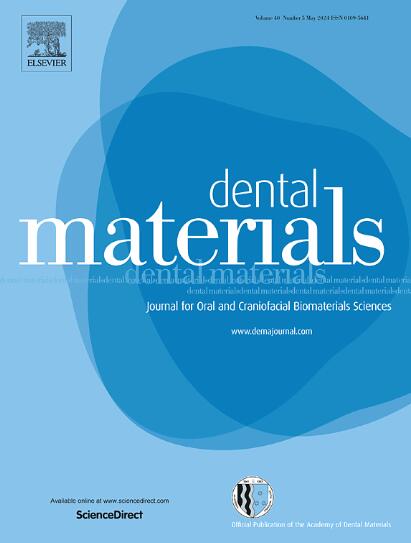甲基丙烯酸表没食子儿茶素没食子酸酯功能化牙胶粘剂:抗蛋白水解活性和牙本质结合研究。
IF 6.3
1区 医学
Q1 DENTISTRY, ORAL SURGERY & MEDICINE
引用次数: 0
摘要
目的:评价egcg -甲基丙烯酸酯单体的抗蛋白水解作用及其对杂交层明胶水解活性的抑制作用。同时,研究了egcg -甲基丙烯酸酯单体功能化胶粘剂对牙本质-树脂近期和长期结合强度的影响。方法:将纯EGCG (E0)与三种不同比例的甲基丙烯酰酯反应,在乙酸乙酯中溶解,得到羟基功能化的EGCG-甲基丙烯酸酯,浓度分别为33 % (M-E33)、67 % (M-E67)和100 % (M-E100)。采用含E0、M-E33、M-E67和M-E100的自蚀刻胶粘剂(wt%为1 )在人牙本质表面构建树脂复合块。将去离子水(DW)或乳酸(LA)浸泡在去离子水(DW)或乳酸(LA)中,然后用DW、丙酮(作为对照)、丙酮稀释的E0、M-E33、M-E67和M-E100处理。采用酶联免疫吸附法测定牙本质基质标本7 d提取物中溶解型I型胶原c端(CTX和ICTP)和n端(NTX)端肽的浓度。牙本质处理24 h后,用共聚焦显微镜对修复牙的粘接剂-牙本质界面切片进行原位酶谱分析。在24 h和6个月后评估微拉伸粘结强度(µTBS)和失效模式。采用双因素方差分析和Tukey事后检验(p )对数据进行分析。结果:所有实验组均显著减少了DW和LA患者牙本质样品中溶解端肽的释放。E0和M-E100加入胶黏剂体系降低了杂化层内的胶溶活性。E0组和M-E100组修复牙的µTBS值分别在24 h和6个月后最低。除M-E100外,观察到的最普遍的故障被归类为4型。意义:egcg -甲基丙烯酸酯单体能有效保护胶原蛋白免受降解。当加入粘合剂体系时,egcg -甲基丙烯酸酯降低了杂化层内的明胶溶解活性,并且不影响修复体的即时和长期粘合强度值。本文章由计算机程序翻译,如有差异,请以英文原文为准。
Methacrylated epigallocatechin gallate functionalized dental adhesives: Antiproteolytic activity and dentin bonding studies
Objectives
To assess the antiproteolytic effect of EGCG-methacrylate monomers and its inhibitory effect on gelatinolytic activity in the hybrid layer. Also, to investigate the effect of an adhesive material functionalized with EGCG-methacrylate monomers on immediate and long-term dentin-resin bond strength. Methods: Neat EGCG (E0) was reacted with three different ratios of methacryloyl ester and dissolved in ethyl acetate to obtain EGCG-methacrylates with hydroxyl functionalization at 33 % (M-E33), 67 % (M-E67) and 100 % (M-E100) levels. Resin composite blocks were built on human dentin surfaces using self-etching adhesive containing E0, M-E33, M-E67, and M-E100 at 1 wt%. Demineralized human dentin disks were immersed in deionized water (DW) or lactic acid (LA) and subsequently treated with DW, acetone (as controls), E0, M-E33, M-E67 and M-E100 diluted in acetone. Concentrations of solubilized type I collagen C-terminal (CTX and ICTP) and N-terminal (NTX) telopeptides were determined from 7-day extracts of dentin matrix specimens by ELISA assays. In situ zymography of adhesive-dentin interface slices from restored teeth was performed by confocal microscope after 24 h dentin treatment. Microtensile bond strength (µTBS) and failure pattern were evaluated after 24 h and 6 months. Data were analyzed using two-way ANOVA and Tukey post hoc test (p < 0.05). Results: All experimental groups statistically reduced the release of solubilized telopeptides from dentin samples in DW and LA. E0 and M-E100 incorporated into the adhesive system reduced the gelatinolytic activity within the hybrid layer. The lowest µTBS values for restored teeth were observed for E0 and M-E100 groups, after 24 h and 6 months, respectively. The most prevalent failure observed was classified as type 4, except for M-E100. Significance: EGCG-methacrylate monomers effectively protected collagen from degradation. When incorporated into adhesive systems, EGCG-methacrylates reduced gelatinolytic activity within the hybrid layer, and did not affect immediate and long-term bond strength values of restorations.
求助全文
通过发布文献求助,成功后即可免费获取论文全文。
去求助
来源期刊

Dental Materials
工程技术-材料科学:生物材料
CiteScore
9.80
自引率
10.00%
发文量
290
审稿时长
67 days
期刊介绍:
Dental Materials publishes original research, review articles, and short communications.
Academy of Dental Materials members click here to register for free access to Dental Materials online.
The principal aim of Dental Materials is to promote rapid communication of scientific information between academia, industry, and the dental practitioner. Original Manuscripts on clinical and laboratory research of basic and applied character which focus on the properties or performance of dental materials or the reaction of host tissues to materials are given priority publication. Other acceptable topics include application technology in clinical dentistry and dental laboratory technology.
Comprehensive reviews and editorial commentaries on pertinent subjects will be considered.
 求助内容:
求助内容: 应助结果提醒方式:
应助结果提醒方式:


